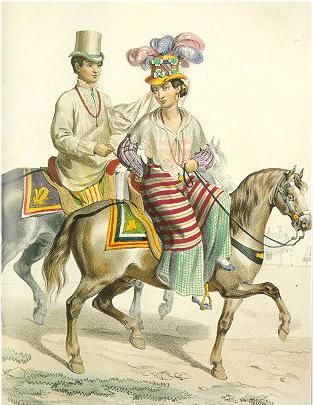Tapis (Philippine Clothing) on:
[Wikipedia]
[Google]
[Amazon]
 Tapis across various cultures in the
Tapis across various cultures in the
 Tapis across various cultures in the
Tapis across various cultures in the Philippines
The Philippines, officially the Republic of the Philippines, is an Archipelagic state, archipelagic country in Southeast Asia. Located in the western Pacific Ocean, it consists of List of islands of the Philippines, 7,641 islands, with a tot ...
may generally refer to a single, rectangular piece of cloth one wraps around oneself as clothing, but is also the term for a colorful, hand-woven wraparound skirt common in the pre-colonial period, and which is still used today as part of the María Clara gown and by culturally conservative tribes.
The tapis worn by the Cordilleran women of Northern Luzon
Luzon ( , ) is the largest and most populous List of islands in the Philippines, island in the Philippines. Located in the northern portion of the List of islands of the Philippines, Philippine archipelago, it is the economic and political ce ...
, known locally as the ''alampay'', are the most prominent surviving example.
It is worn by wrapping the cloth around one's waist and holding the ends together by means of a tightly tied sash. It generally reaches down to the knees. The woven pattern of a tapis describes the culture and temperament of the wearer's tribe.
Broader usage (verb)
Another use of the term, as a verb, simply means to wrap a piece of cloth around one's body to cover it up. A person who does so is said to be ('putting on a tapis'). This usage of the term does not require that the piece of cloth be a traditional tapis, and can refer to being wrapped in a blanket or towel.In historical records
The Tapis has been in use in the Philippine archipelago since at least the indigenous period before the arrival of Europeans. Spanish chroniclers from the period noted that this mode of dress remained common on many islands despite Spanish efforts to introduce what they considered more suitable clothing. They felt that the tight profile of the tapis on a female wearer was revealing and immodest, and made even worse by the often sheer fabric of the cloth. One noted that the tapis became even more revealing whenever the wearer was caught in the rain, or had just taken a bath. The locals, however, did not consider the revealing properties of the tapis to be immodest. Among the lowland peoples who came under the full influence of Spain, this would soon change asChristianization
Christianization (or Christianisation) is a term for the specific type of change that occurs when someone or something has been or is being converted to Christianity. Christianization has, for the most part, spread through missions by individu ...
and Hispanization forced a much more conservative cultural imperialism, and along with it, a mode of dress that emphasized a Christian-colonial sense of subjective modesty. The tapis would continue to be worn, but not in public, and usually only in more intimate settings such as one's own house. The tapis saw continued use among upland peoples, but as their environments are colder, their variations of the tapis tended to be thicker and thus less revealing.
See also
* Bahag (garment) * Patadyong * Malong * Abacá * Batik * Inabel *Pañuelo
The ''pañuelo'' or ''alampay'' is a Philippines, Filipino lace-like embroidered neck scarf or shawl worn around the shoulders over the ''camisa'' (blouse). They were square-shaped and were folded in half into a triangle when worn. ''Pañuelos' ...
*Piña
Piña ( ) is a traditional Philippine fiber made from the leaves of the pineapple plant. Pineapples are indigenous to South America but have been widely cultivated in the Philippines since the 17th century, and used for weaving lustrous lace- ...
* T'nalak
References
{{reflist Philippine clothing History of Asian clothing Philippine handicrafts